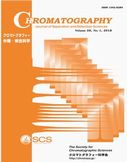Volume 39, Issue 3
Displaying 1-9 of 9 articles from this issue
- |<
- <
- 1
- >
- >|
Original Papers
-
2018 Volume 39 Issue 3 Pages 105-111
Published: October 20, 2018
Released on J-STAGE: November 08, 2018
Advance online publication: May 20, 2018Download PDF (861K) -
2018 Volume 39 Issue 3 Pages 113-118
Published: October 20, 2018
Released on J-STAGE: November 08, 2018
Advance online publication: September 25, 2018Download PDF (1991K) -
2018 Volume 39 Issue 3 Pages 119-124
Published: October 20, 2018
Released on J-STAGE: November 08, 2018
Advance online publication: September 25, 2018Download PDF (915K) -
2018 Volume 39 Issue 3 Pages 125-130
Published: October 20, 2018
Released on J-STAGE: November 08, 2018
Advance online publication: October 02, 2018Download PDF (1228K) -
2018 Volume 39 Issue 3 Pages 131-137
Published: October 20, 2018
Released on J-STAGE: November 08, 2018
Advance online publication: September 29, 2018Download PDF (395K) -
2018 Volume 39 Issue 3 Pages 139-146
Published: October 20, 2018
Released on J-STAGE: November 08, 2018
Advance online publication: October 04, 2018Download PDF (1376K) -
2018 Volume 39 Issue 3 Pages 147-152
Published: October 20, 2018
Released on J-STAGE: November 08, 2018
Advance online publication: October 12, 2018Download PDF (1091K) -
2018 Volume 39 Issue 3 Pages 153-160
Published: October 20, 2018
Released on J-STAGE: November 08, 2018
Advance online publication: October 04, 2018Download PDF (1712K)
Short communications
-
2018 Volume 39 Issue 3 Pages 161-165
Published: October 20, 2018
Released on J-STAGE: November 08, 2018
Advance online publication: September 29, 2018Download PDF (1097K)
- |<
- <
- 1
- >
- >|
